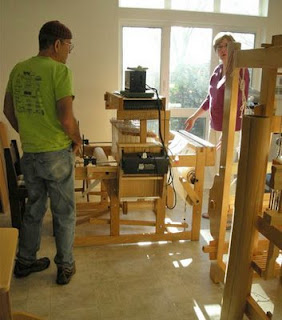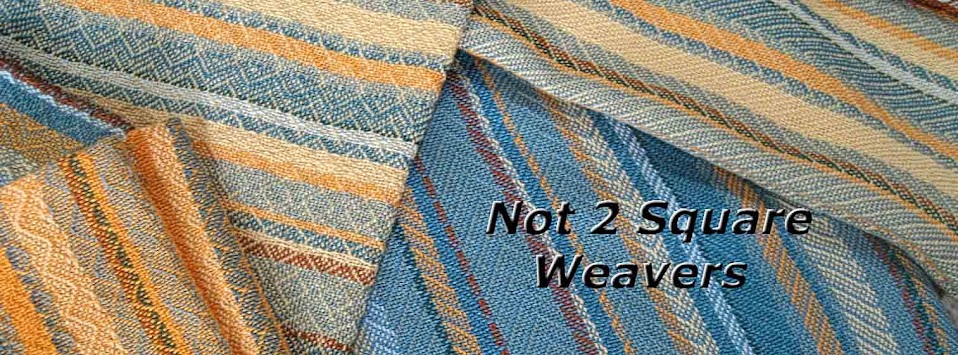
The weather was beautiful for our January get together and we had a great meeting of show and tell and a little glass drying experiment with handwoven towels to end up the day.
Dee brought in a new shawl that she wove with some of her handspun mohair and a decorative ribbon. The ribbon laid perfectly flat without twists in the shawl. Dee said she put it in a dent with a finer thread of rayon and didn't fuss with it during the weaving.

Dee also had a nice piece of yardage she hopes to make into a jacket.

Diana brought a couple of napkins she had recently completed. She used a draft from an e-book she downloaded. Top Ten Towels on Eight Shafts One of her napkins had hemstitched edges with a small fringe; the other had a machine stitched hem. I think I liked the hemstitched edge the best.
Here is a detail of the cotton and rayon chenille scarf in shadow weave Gus brought to the meeting. Shadow weave seems to be a good structure for chenille because the floats are small, diminishing the tendency of the chenille to worm.

Ingrid took us downstairs to her weaving studio so she could show off her new AVL Computer Dobby loom. She has her first warp wound on the beam and is threading heddles. The weaving width on this sweet loom is 36" -- just perfect for scarves, towels, shawls etc. Her main Cranbrook loom is off to the right in the photo.
Brand new weaver, Paulette, has woven a series of goose eye twill dish towels. The warp is white and she used a different color weft for each towel.
Paulette also brought in this scarf, which she considered a failure as a scarf because it was too heavy and dense. She used a novelty suede type yarn for the warp and a nylon fuzzy yarn for the weft. I thought that it might make a cute purse and someone else suggested using it as a table runner. Anyway, it was a very interesting piece of cloth and we were glad she brought it for us to think about what went wrong and how it could be utilized in a way other than she originally intended.

This is Paulette's very first weaving project made under the tutelage of Gus. It is warp and weft rayon chenille with a touch of gold metallic in the warp. With such a success as a first project, we think that Paulette has quite a future as a weaver.
Ingrid showed one of her Christmas towels. They are of fine white cotton in plain weave, with a rosepath row of Christmas trees on one end. We feel that these are not belated 2008 Christmas towels, but a good head start on Christmas 2009!
Sue H. shared her ideas about doing a strip woven garment. She wants to weave up some denim colored cotton yarns she has in her stash and sew a casual jacket. She showed a very interesting picture of a jacket found in a catalog that she is using for inspiration.
Sue R. has her loom warped and is weaving her first towel. We convinced her to use some of her warp to weave napkins for our May exchange.
Igor and I jointly wove off a warp of mixed cottons using the bumberet and ducape drafts shown in the previous post. I used the warping paddle I bought from Kerry and warped 10 mixed cotton threads at one time. The towels contained 8/2, 10/2, 16/2 and 20/2 blue and green cottons I had in my stash. When one yarn looked like it was going to run out, I threaded a new one into the paddle. I'm finding the technique works well on my warping wheel, but is more difficult when using a warping board. The angle at which you are approaching your warping device seems to be the determining factor in how easily you can transfer the cross from the paddle to the warping board.
The meeting ended with a rather unscientific attempt at seeing what fiber and structure types make the best dish towels. We tried a mercerized cotton, unmercerized cotton, cottolin- unmercerized cotton and all linen. Most of our towels left lint on the glasses we were drying which was something I didn't expect from the linen towel. My favorite towel was woven with an unmercerized cotton warp and a cottolin weft. It really dries dishes and hands quickly. I also liked a finely woven towel in unmercerized cotton which fits into glassware easily. We tried out a very closely woven twill towel of unmercerized cotton. It was much too dense a fabric to soak up water easily, telling us that the weave structure and sett are very important . If you have done your own experiments to determine the best fiber and structure for towels, please feel free to share your ideas in the comment section.
Next month's meeting discussion will be about selling your handwovens. We will be interested in venues, pricing and marketing tips.





